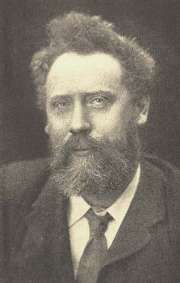|
Biografie William Ernest Henley
William Ernest Henley (23 August 1849 – 11 July 1903) was an English poet, critic and editor.
Born 23 August 1849
Gloucester, England
Died 11 July 1903 (aged 53)
Occupation Poet, critic and editor
Nationality English
Education The Crypt School, Gloucester
Writing period c. 1870–1903
Henley was born at Gloucester and was the eldest of a family of six, five sons and a daughter. His father, William, was a bookseller and stationer who died in 1868 leaving young children and creditors. His mother, Mary Morgan, was descended from the poet and critic, Joseph Warton. From 1861-67 Henley was a pupil at the Crypt Grammar School (founded 1539). A Commission had recently attempted to revive the school by securing the brilliant and academically distinguished T. E. Brown (1830-1897) as headmaster. Brown's appointment was short-lived (c.1857-63) but was a 'revelation' for Henley because it introduced him to a poet and 'man of genius - the first I'd ever seen'. This was the start of a lifelong friendship and Henley wrote a glowing memorial to Brown in the New Review (December, 1897): "He was singularly kind to me at a moment when I needed kindness even more than I needed encouragement".[1]
From the age of 12 Henley suffered from tuberculosis of the bone leading to the amputation of his left leg below the knee either in 1865 or 1868-69.[2] Frequent illness often kept him from school, although the fortunes of his father's business may also have contributed. In 1867, Henley passed the Oxford Local Schools Examination and soon afterwards moved to London where he attempted to establish himself as a journalist.[3] However, his work over the next eight years was interrupted by long periods in hospital because his right foot was also diseased. Henley fought the diagnosis that a second amputation was the only way to save his life by placing himself under the care of the pioneering surgeon Joseph Lister (1827-1912) at the The Royal Infirmary of Edinburgh. After three years in hospital (1873-75), Henley was discharged. Lister's treatment had not effected a complete cure but enabled Henley to lead a relatively active life for nearly 30 years. His friend, Robert Louis Stevenson, based his Treasure Island character, Long John Silver, on Henley
|




